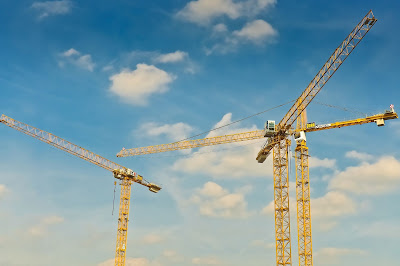The fact is irrefutable that the construction and
manufacturing industries are proliferating. It is not only large-scale
businesses that are heavily contingent on these moguls but small-scale
enterprises too are making a full-fledged use of these industries' many
processes, products, and by-products.
Albeit their definitions have similarities, construction and
manufacturing are distinct business processes. Both involve manual labor to
produce something, materials or products, for commercial purposes. Construction
generally refers to the creation of physical structures such as buildings,
bridges or roadways. Manufacturing typically refers to the production of
finished goods sold to distributors, retailers or consumers.
Image Credit - Pexels
What invariably piques my
curiosity is one construction-related question - where do heavy-duty cranes and
other equipage come from? We all see a profusion of these gigantic machines at
all construction sites. Sometimes the mere thought that somebody actually deals
in construction equipage seems ludicrous. Is this industry fraught with
deception too or there are reliable manufacturers?
Monorailsmanufacturers in Bangalore SGF Fab are affording infallible
construction equipage from ages. These precast
handling crane manufacturers provide an array of cranes, material handling
equipment, and industrial fabrications that hasten the construction process, or
any other type of job. What distinguishes them from their contemporaries is the
customization of equipage.
Doublegirder gantry - goliath manufacturers SGF Fab also provide cranes that are used in
transporters, trenches, erection of bulky equipment, shifting of heavy loads,
mine quarries, and heavy fabrication
units. With the capability of
lifting loads up to 10 T, double girder EOT
cranes are versatile and robust.
With a convoluted and intricate
design pattern, double girder gantry cranes are more robust than single girder
gantry cranes. Steel duty cranes manufacturers SGF Fab supply reliable and
dependable 30, 50, 100, 150 T double girder gantry cranes. Normally, they range
from 5 T to 160 T.
You see, it is a vast subject. However, this should not
intimidate you. Learn the ropes of manufacturing and construction without cudgeling
your brain.
Construction Basics
Construction
companies generally work outside, something that distinguishes them from
manufacturing companies. They use construction materials such as drywall,
asphalt, brick, cement, concrete and various binding applications to build
physical structures. Construction companies work for private individuals or
businesses as well as government employers on projects for hire.
Manufacturing Basics
This
industry employs internal processes. Manufacturing companies employ workers
inside a factory or manufacturing plant. Employees typically work in a
particular division or on a manufacturing assembly line. Manufacturing involves
manual labor and automated processes used to turn raw materials into finished
goods for sale. Manufacturing the first step in the conventional distribution channel, which outlines the flow of products from initial development through
sale to the end customer. Manufacturers typically sell to distributors, who
sell to retailers, who sell to consumers. It is an inextricable chain.
Machines vs. Tools
Manufacturing and construction involve some level of manual labor.
However, a significant distinction between manufacturing and construction is
that manufacturers rely heavily on equipment where as construction workers
typically use more hand tools. Manufacturing plants typically try to maintain
updated equipment that optimizes production quality and efficiency.
Construction workers require hand tools supplies that are not only modern, but
also in good condition to optimize the efforts of manual workers.
Quality
Manufacturers and construction companies must both typically produce
good quality to succeed in business. However, the implications of poor quality
vary between them. If manufacturers produce poor quality products, their brand
becomes devalued, they lose customers, and the ultimately face low sales and
poor business conditions. If construction quality is poor, buildings are not
safe, building inspectors may not approve commercial buildings for use, and the
construction company may develop a poor reputation and lose business.
(With inputs from Chron)

Comments
Post a Comment